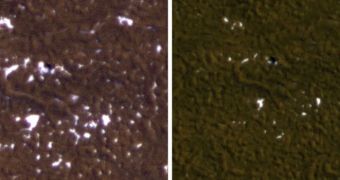In late 2008, mission managers at the NASA Jet Propulsion Laboratory (JPL), in Pasadena, California, lost contact with the Phoenix Mars Lander. This is the science platform that managed to establish for a fact that water-ice exists at high northern latitudes on Mars. The machine remained operational for longer than it was meant to, and now experts are hopeful that, as the winter of the Red Planet is replaced by spring, the robot will come back to life.
As such, the Mars Odyssey orbiter is currently conducting a new listening campaign, in which it will try to make out potential radio signals sent by the awoken lander. Two other campaigns of this nature have been conducted over the past couple of months, but thus far they have yielded no palpable result. Experts hope that, as time passes, the amount of sunlight bathing the robot will be enough to make it get out of the “Lazarus mode” they hope it is in at this point. This is a special feature that has been built into the machine for this very purpose, but no one is sure whether it would actually work.
As the Martian winter set in at the high latitudes Phoenix landed in, it battered the machine with extremely cold temperatures, at the same time preventing sunlight from reaching it. If, however, sufficient energy remained in its batteries, it will awaken, and start to transmit messages, in an attempt to contact available orbiters around Mars. Still, NASA officials cannot afford to detour Odyssey – in orbit around the Red Planet since 2001 – from its regular science duties for a long time.
Throughout next week, Odyssey will conduct about 60 flights above Phoenix's location, which is currently bathed in sunlight throughout the day. NASA experts say that, if the solar panels endured the winter without suffering irreparable damage, then they should have enough power by now to allow for the lander to communicate telemetry data about itself. They add that the January and February campaigns were somewhat of a long shot, given that the amount of sunlight, which reached Phoenix at the time was clearly insufficient to allow for its revival. However, they add that, even now, the probability of the lander waking up is still remote, Space reports.

 14 DAY TRIAL //
14 DAY TRIAL //